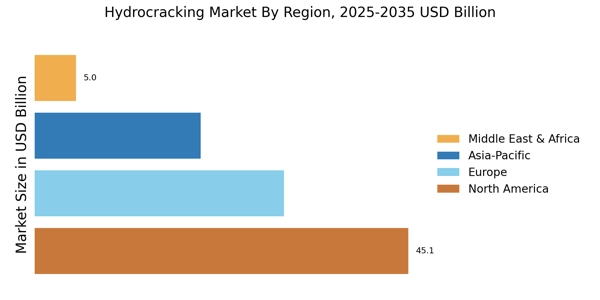Rising Demand for Clean Fuels
The Hydrocracking Market is experiencing a notable increase in demand for cleaner fuels, driven by stringent environmental regulations and consumer preferences for sustainable energy sources. As countries implement policies aimed at reducing carbon emissions, the need for low-sulfur diesel and other clean products derived from hydrocracking processes becomes more pronounced. In 2025, the demand for clean fuels is projected to rise by approximately 5% annually, indicating a robust growth trajectory for the hydrocracking sector. This shift not only aligns with global sustainability goals but also presents opportunities for refiners to enhance their product offerings, thereby solidifying their position in the Hydrocracking Market.
Shifts in Feedstock Availability
The availability of feedstock is a crucial factor influencing the Hydrocracking Market. As the energy landscape evolves, refiners are increasingly turning to alternative feedstocks, such as bio-based materials and heavier crude oils, to meet the demands of the market. This shift is driven by both economic considerations and the need for diversification in feedstock sources. In 2025, it is anticipated that the use of alternative feedstocks in hydrocracking processes could increase by 20%, reflecting a broader trend towards resource optimization. Such changes not only impact the operational dynamics of the Hydrocracking Market but also present new challenges and opportunities for refiners.
Increasing Investment in Refinery Upgrades
Investment in refinery upgrades is a significant driver for the Hydrocracking Market. As refineries seek to modernize their operations and meet the growing demand for high-quality fuels, many are allocating substantial capital towards hydrocracking units. In recent years, it has been observed that investments in hydrocracking technology have surged, with estimates suggesting that over $10 billion will be spent on new hydrocracking facilities and upgrades by 2026. This influx of capital not only enhances the operational capabilities of existing refineries but also facilitates the development of new facilities, thereby expanding the overall capacity of the Hydrocracking Market.
Technological Innovations in Hydrocracking
Technological advancements play a pivotal role in shaping the Hydrocracking Market. Innovations such as improved catalyst formulations and advanced reactor designs are enhancing the efficiency and yield of hydrocracking processes. For instance, the introduction of novel catalysts has been shown to increase conversion rates by up to 15%, thereby maximizing output while minimizing operational costs. Furthermore, the integration of digital technologies, including process optimization software, is enabling refiners to monitor and adjust operations in real-time, leading to enhanced productivity. As these technologies continue to evolve, they are likely to drive further growth in the Hydrocracking Market, making it more competitive and efficient.
Regulatory Pressures and Compliance Requirements
Regulatory pressures are a significant driver of change within the Hydrocracking Market. Governments worldwide are implementing stricter regulations regarding emissions and fuel quality, compelling refiners to adopt hydrocracking technologies that comply with these standards. The introduction of regulations such as the Euro 6 standards for vehicle emissions has necessitated the production of ultra-low sulfur fuels, which are primarily derived from hydrocracking processes. As compliance becomes increasingly critical, refiners are likely to invest in hydrocracking technologies to ensure they meet these evolving requirements. This trend not only drives growth in the Hydrocracking Market but also fosters innovation as companies seek to develop more efficient and compliant processes.


















Leave a Comment